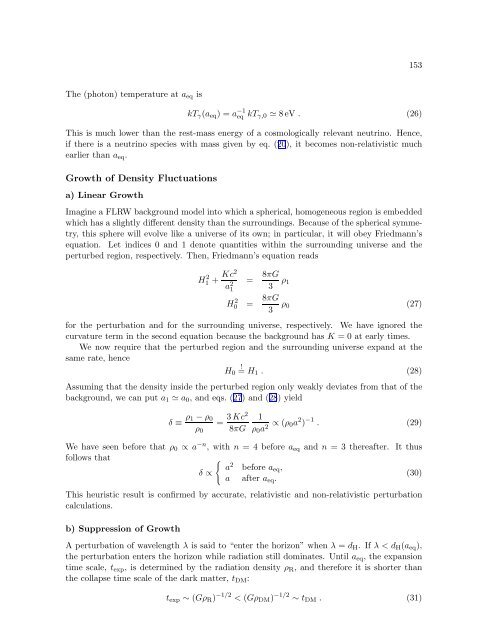Proc. Neutrino Astrophysics - MPP Theory Group
Proc. Neutrino Astrophysics - MPP Theory Group
Proc. Neutrino Astrophysics - MPP Theory Group
You also want an ePaper? Increase the reach of your titles
YUMPU automatically turns print PDFs into web optimized ePapers that Google loves.
The (photon) temperature at aeq is<br />
153<br />
kTγ(aeq) = a −1<br />
eq kTγ,0 ≃ 8eV . (26)<br />
This is much lower than the rest-mass energy of a cosmologically relevant neutrino. Hence,<br />
if there is a neutrino species with mass given by eq. (20), it becomes non-relativistic much<br />
earlier than aeq.<br />
Growth of Density Fluctuations<br />
a) Linear Growth<br />
Imagine a FLRW background model into which a spherical, homogeneous region is embedded<br />
which has a slightly different density than the surroundings. Because of the spherical symmetry,<br />
this sphere will evolve like a universe of its own; in particular, it will obey Friedmann’s<br />
equation. Let indices 0 and 1 denote quantities within the surrounding universe and the<br />
perturbed region, respectively. Then, Friedmann’s equation reads<br />
H 2 1<br />
+ Kc2<br />
a 2 1<br />
= 8πG<br />
3 ρ1<br />
H 2 0 = 8πG<br />
3 ρ0<br />
for the perturbation and for the surrounding universe, respectively. We have ignored the<br />
curvature term in the second equation because the background has K = 0 at early times.<br />
We now require that the perturbed region and the surrounding universe expand at the<br />
same rate, hence<br />
H0 ! = H1 . (28)<br />
Assuming that the density inside the perturbed region only weakly deviates from that of the<br />
background, we can put a1 ≃ a0, and eqs. (27) and (28) yield<br />
δ ≡ ρ1 − ρ0<br />
ρ0<br />
= 3Kc2<br />
8πG<br />
(27)<br />
1<br />
ρ0a 2 ∝ (ρ0a 2 ) −1 . (29)<br />
We have seen before that ρ0 ∝ a−n , with n = 4 before aeq and n = 3 thereafter. It thus<br />
follows that<br />
�<br />
a<br />
δ ∝<br />
2 a<br />
before aeq,<br />
after aeq.<br />
(30)<br />
This heuristic result is confirmed by accurate, relativistic and non-relativistic perturbation<br />
calculations.<br />
b) Suppression of Growth<br />
A perturbation of wavelength λ is said to “enter the horizon” when λ = dH. If λ < dH(aeq),<br />
the perturbation enters the horizon while radiation still dominates. Until aeq, the expansion<br />
time scale, texp, is determined by the radiation density ρR, and therefore it is shorter than<br />
the collapse time scale of the dark matter, tDM:<br />
texp ∼ (GρR) −1/2 < (GρDM) −1/2 ∼ tDM . (31)













